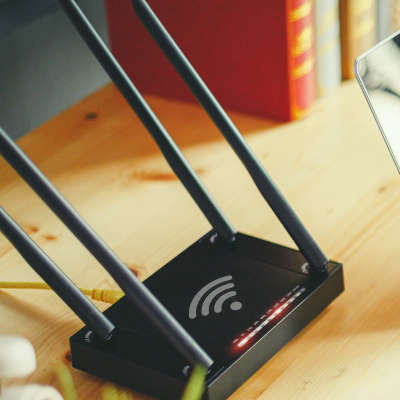
KB Technologies Blog
KB Technologies has been serving the Deerfield Beach area since 2002, providing IT Support such as technical helpdesk support, computer support, and consulting to small and medium-sized businesses.
Before You Buy: Getting the Most Out of Your Wireless Network
Nearly everyone uses Wi-Fi. Wireless gives people the increased flexibility to use their mobile devices in more places. If your business’ Wi-Fi isn’t set up properly, you’ll find that your coverage will be lacking. Today, we thought we’d give you a few tips on how to set up your Wi-Fi connection so that it works best for your business.
You Need to Identify Your Wi-Fi’s Purpose
The first thing you will need to know is how you plan to use your wireless network. If your business is looking for a cost-effective way to get more Internet coverage, setting up a WLAN is one of your best options. You’ll want to ensure that you plan your Wi-Fi network for the amount of users and their uses. Most Wi-Fi connections are simpler to set up and manage than a wired network so as long as you have a good idea of what your users’ needs are, you should be able to ascertain what options you are going to need as far as router hardware and service extensions.
You’ll also want to audit the devices that need to connect wirelessly to the network. Some older devices may not connect to newer standards. That’s not a huge problem, since many routers can support older devices, but it’s important to be aware.
You Will Want to Map Out a Coverage Area
Do you want your Wi-Fi to extend past the boundaries of your business? Do you want to set it up in a way where it is only available to certain people? To get what you need your Wi-Fi network to do, you will want to plan out where your router will be set up and how you want it set up. Having a plan will go a long way toward simplifying the whole process.
Bandwidth
One of the biggest considerations you will need to know will be how much bandwidth your organization needs. By taking time and projecting possible bandwidth you will be able to learn a couple critical details for your implementation. One is how much you will pay for the bandwidth and another is how your bandwidth will be spent. Once you know all the particulars, you can successfully calculate your business’ networking costs.
Procure Hardware
Acquiring the hardware you’ll need is pretty straightforward, but you’ll need to get hardware that supports the wireless standard you plan on using. The most utilized standards for high speed wireless transmission are 802.11a and 802.11g. 802.11b is also reliable but delivers slower Internet speeds.
Deployment
Ultimately, the placement of your hardware is the biggest consideration as far as setting up a reliable Wi-Fi connection. Some businesses will need multiple connections running from multiple routers. You will want to set your router up centrally and strategically. Additionally, a lot of businesses want to build their wireless network to include guest use, so you will also want to consider how available your wireless signal is in order to fulfill the next task.
Plan and Implement Security
Your WI-Fi hardware runs an operating system just like your computer and you will want to configure it to meet the needs of your business. There are security options that need to be consistently updated to keep unwanted threats out of your network. This is the part of the process where you could benefit greatly from the knowledge and experience of a certified technician. While you may understand that you need to update firewall permissions, assign user access, and much more, a professional will understand the specifics of it and can really work to keep your Wi-Fi network much more secure than it would otherwise be.
Here are a few suggestions, should you want to undertake this procedure yourself:
- Change your router’s factory-set admin password - The first step in most security practices is changing the password. It is the same for setting up your router(s).
- Turn off Service Set Identifier (SSID) broadcasting - This doesn’t allow passersby to see that your wireless network is up and available.
- Change default SSID - Since a lot of factory-provided SSID values are available, you can avoid them altogether by changing the SSID login name.
- Enable MAC address filtering - This gives you control over which users have access to what access points.
- Add EAP authentication and enable encryption - Requires secure authentication from each user on the network.
- Consider secure remote access or virtual private networking - This provides users operating outside your network the means to send and receive data securely.
A solid Wi-Fi connection can be a major benefit for any type of organization. If you would like to discuss the process with a technician from KB Technologies, give us a call at (954) 834-2800 today.
Tired Of Annoying Computer Problems That Keep Coming Back?
Reach Out Today!
Mobile? Grab this Article!
Tag Cloud
Workplace Strategy
Ransomware
Malware
Productivity
Google
User Tips
Security
Business Computing
Cloud
Hackers
Collaboration
Hardware
Innovation
Cybersecurity
Disaster Recovery
Tip of the Week
Technology
Quick Tips
Current Events
Efficiency
Workplace Tips
Data Recovery
Business
Data
Managed IT Services
Internet
IT Support
Privacy
Phishing
Mobile Device
IT Services
Backup
Saving Money
Best Practices
Microsoft
Hosted Solutions
Software
Users
Network Security
Email
Latest Blog
Nowadays, small and medium-sized businesses need the right technological tools to drive efficiency and growth. Software-as-a-Service has emerged as a powerful, accessible model transforming business operations. Understanding SaaS, its benefits, potential management hurdles, ...
Latest News
KB Technologies is proud to announce the launch of our new website at http://www.kb-it.com. The goal of the new website is to make it easier for our existing clients to submit and manage support requests, and provide more information about our services for ...


Comments